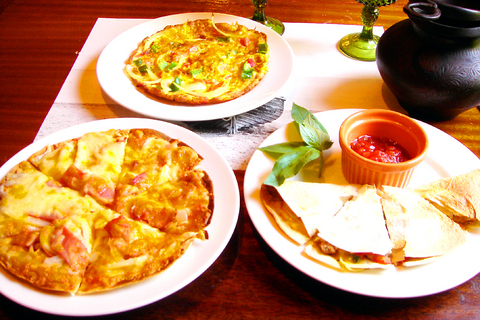A tapas restaurant in Taiwan can generally head in either of two directions; use imported ingredients and stick fastidiously to the Spanish formula, charging top dollar for authenticity, or use locally sourced produce and cater for native palates with more reasonably priced meals.
Barcelona, a newly opened tapas bar and restaurant owned and operated by Luisa Ting (
Purists may scoff at this approach, but with an all-you-can-eat lunch menu priced at NT$450 including service charge (NT$499 for dinner), and buy-one-get-one-free offers on beverages that include Fosters, Stella Artois, Carlsberg and Boddingtons on tap, as well as a la carte main dishes ranging from NT$120 to NT$200 this restaurant is a good choice for people with healthy appetites.

PHOTO COURTESY OF CHANG CHUN-HAO
Within walking distance from the Eastern District's main shopping drag, Zhongxiao East Road, Barcelona is conveniently located in a lane off Yanji Street and unlike many cramped eateries in the area is quite large, able to comfortably sit around 90 people.
From inside there is an agreeable view of an adjacent park opposite the bar. Terracotta tile flooring at the front and dark wood floorboards at the back, timber roof beams, white washed walls and simple, functional furniture lend the place a relaxed rustic atmosphere.
The service, provided by staff well experienced in the catering trade is prompt, and the proprietor is flexible, willing to keep the place open past the usual 2am closing time if patrons are still drinking.
The tapas selection at Barcelona consists of 10 dishes, such as chorizo fried with garlic and onions. Ting researched Spanish recipes and found a local producer to make the spicy, highly seasoned piquant sausages to order. Buffalo wings, lightly marinated, are served plain, an unusual departure from the standard version usually coated in a savory sauce.
The main course options are pasta, gratin, pizza and paella. Paella, one of Spain's national dishes comes in many varieties, but common to most is the use of rice, tomatoes and saffron.

Many people noticed the flood of pro-China propaganda across a number of venues in recent weeks that looks like a coordinated assault on US Taiwan policy. It does look like an effort intended to influence the US before the meeting between US President Donald Trump and Chinese dictator Xi Jinping (習近平) over the weekend. Jennifer Kavanagh’s piece in the New York Times in September appears to be the opening strike of the current campaign. She followed up last week in the Lowy Interpreter, blaming the US for causing the PRC to escalate in the Philippines and Taiwan, saying that as

Nov. 3 to Nov. 9 In 1925, 18-year-old Huang Chin-chuan (黃金川) penned the following words: “When will the day of women’s equal rights arrive, so that my talents won’t drift away in the eastern stream?” These were the closing lines to her poem “Female Student” (女學生), which expressed her unwillingness to be confined to traditional female roles and her desire to study and explore the world. Born to a wealthy family on Nov. 5, 1907, Huang was able to study in Japan — a rare privilege for women in her time — and even made a name for herself in the

This year’s Miss Universe in Thailand has been marred by ugly drama, with allegations of an insult to a beauty queen’s intellect, a walkout by pageant contestants and a tearful tantrum by the host. More than 120 women from across the world have gathered in Thailand, vying to be crowned Miss Universe in a contest considered one of the “big four” of global beauty pageants. But the runup has been dominated by the off-stage antics of the coiffed contestants and their Thai hosts, escalating into a feminist firestorm drawing the attention of Mexico’s president. On Tuesday, Mexican delegate Fatima Bosch staged a

Taiwan can often feel woefully behind on global trends, from fashion to food, and influences can sometimes feel like the last on the metaphorical bandwagon. In the West, suddenly every burger is being smashed and honey has become “hot” and we’re all drinking orange wine. But it took a good while for a smash burger in Taipei to come across my radar. For the uninitiated, a smash burger is, well, a normal burger patty but smashed flat. Originally, I didn’t understand. Surely the best part of a burger is the thick patty with all the juiciness of the beef, the